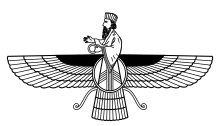Faravahar
Faravahar or Farohar, Forouhar, Firavarti, Fravahar and Farvahar is according to Zoroastrian tradition a symbol of the human spirit , which already exists before the birth and also after the death of a person. The symbol is also used by Persians as a non-religious sign.
In the Achaemenid Empire , the symbol Faravahar also represented a national emblem carved into palaces and monuments and is still considered by many Persians to be the “ancient symbol of the ancestors”.
Faravahar is a symbol of the three basic principles of Zoroastrianism: Good thinking ( Persian پندار نیک, DMG pendār-e nīk ), good speaking ( Persian گفتار نیک, DMG goftār-e nīk ) and doing good ( Persian کردار نیک, DMG kerdār-e nīk ).
However, this symbol should not - as is often the case - be viewed as an image of the god Ahura Mazda . According to Herodotus, there were no portraits of Ahura Mazda in ancient Iran , the symbol of light or fire was chosen for him. Faravahar shows opposing forces which, according to Zarathustra, work in the spirit of the human being (as a constant inner struggle) and aim at a maturation process of the human being before the spirit leaves the mortal body and (depending on the behavior in life) approaches a higher level of existence can (Some authors understand this to mean that the good / divine principle in the person of Ahura Mazda is constantly in conflict with the evil / diabolical one in Ahriman - also in the sense of a dualism ).
A symbol associated with the Assyrian deity Aššur shows similarities.
The term Faravaschi , which is etymologically related to Faravahar, refers to a kind of protective spirit that protects people on their way to God.
Word origin
The name Faravahar is derived from the Avestian name Firavarti. Fara or Fira means to fly or the one who flies . Vahar or rather varti means choosing the good or choosing the good spirit . So the name Faravahar means the Supreme Chosen Good Spirit who flies out of purity.
Symbol of the Faravahar
- The face of Faravahar resembles a person and thus establishes the connection to the people.
- The two wings of the portrait have three main feathers and are to be interpreted as a symbol for the principles of “ thinking well ”, “ speaking well ” and “ acting well ” that enable one to move forward .
- The lower part of the Faravahar also consists of three parts, but these are the signs of “ thinking badly ”, “ speaking badly ” and “ doing badly ” and thus of deeds that bring bad luck to people.
- In both sides of this symbol there are two loops that mean “ Sepanta Mainyu” (the good force) and “ Angra Mainyu ” (the evil force). The first loop (good strength) points towards the face and the second (evil force) points towards the back. People should therefore turn their face to the good and turn their backs on the evil in order to strengthen the inherent power of the good and to suppress the power of the evil in them.
- The body of Faravahar is surrounded by a circle, the sign that the human spirit is immortal and therefore has no beginning or end.
- A hand from Faravahar pointing upwards is supposed to show the way to the progress that should be striven for by man. The ring in the other hand is sometimes interpreted as a symbol of loyalty, which occupies a high position in this teaching.
Faravahar in Persepolis
Fire temple in Yazd
Faravahar above the Behistun inscription of Darius I (r. 522-486)
See also
Web links
Individual evidence
- ↑ Bahram Varza: The Teaching of Zarathustra. In: Borsuye. Journal for Medicine a. Culture. Volume 8, 1996, No. 31, pp. 15-19, here: pp. 16 f. ( Faravahar ).
- ↑ Catherine Beyer Catherine Beyer has taught religion in at Lakel, College in Wisconsin as well as humanities, Western culture at the University of Wisconsin, Green Bay: What Does the Winged Symbol of Zoroastrianism Mean? Retrieved December 13, 2018 .
- ↑ Sacred Symbols. Retrieved December 13, 2018 .
- ↑ Sina Vodjani and Gabriele von Kröcher: Zarathustra. Membrane International, Hamburg 2006, ISBN 978-3-86562-739-1 , p. 20 f.
- ↑ Bahram Varza: The Teaching of Zarathustra. 1996, p. 16.
- ^ SM Iqbal : The development of metaphysics in Persia. (Philosophical dissertation Munich) Luzac & Co., London 1908, p. 10.
- ↑ Bahram Varza: The Teaching of Zarathustra. In: Borsuye. Journal for Medicine a. Culture. Volume 8, 1996, No. 31, pp. 15-19, here: pp. 16 f.



